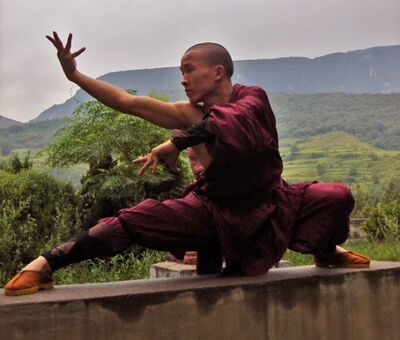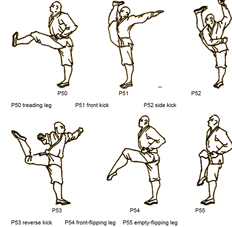| Kung Fu (功夫) | |
|---|---|
 Shaolin Monk | |
| Also called | Gung Fu, Wushu ( 武术) |
| Country of origin | China |
| Parent arts | Ancient Sport of jǐao dǐ (角抵, horn butting) |
| Descendant arts | Various Schools |
| Focus | Hand and Arm, Kicks (Northern Styles 北派), Internal (Tai chi chuan) |
The term Kung Fu refers to the martial arts of China. Kung Fu originated in a place called the Shaolin Temple,
where monks practiced Kung Fu for health and self-defense during their quest for enlightenment.
The first Shaolin temple was a Buddhist monastery built in 377 A.D. in the Henan province of China. In 527 A.D. a Buddhist prince, Bodhidharma, or Da Mo in Chinese, traveled to the temple for religious teaching, but found the monks weak and in poor health. To find a way to give the monks strength and vitality, Da Mo locked himself in a room for nine years of meditation. His resulting work, Yi Jin Jing, a series of exercises which developed strength, vitality, and internal energy, is considered the original Shaolin martial art. Chinese martial arts. Some examples of Kung Fu styles are Long Fist, Eagle Claw, and Taiji Quan.
Another misconception is that Kung Fu is a "soft" style compared with Karate or other "hard" styles. This is not so: each Kung Fu style contains both hard and soft techniques. Also, many people believe that Kung Fu is an external style and Taiji Quan is an internal style. While most Kung Fu styles emphasize external development, all styles of Kung Fu contain both internal and external components.
Styles
Northern Styles (北派)
Běi pài (北派) feature deeply extended postures—such as the horse, bow, drop, and dragon stances—connected

by quick fluid transitions, able to quickly change the direction in which force is issued. The group of Northern martial arts includes many illustrious styles such as Baguazhang, Bajiquan, Chāquán, Chuojiao, Eagle Claw, Northern Praying Mantis and Taijiquan. Chángquán is often identified as the representative Northern style and forms a separate division in modern Kung Fu curriculum. Northern styles exhibit a distinctively different flavor from the martial arts practiced in the South. In general, the training characteristics of northern styles put more focus on legwork, kicking and acrobatics. The influence of Northern styles can be found in traditional Korean martial arts and their emphasis on high-level kicks.
South Styles (南派)
Southern Chinese martial arts (南派) feature low stable stances and short powerful movements that combine both attack and defense. In practice, Nanquan focus more on the use of the arm and full body techniques than high kicks or acrobatic moves. There are various explanations for those characteristics. The influence of Southern styles can be found in Goju Ryu, a karate style from Okinawa.
Techniques

Kung Fu (also known as Gung Fu or Wushu) is a Chinese martial arts that focuses primarily on hand & arm strikes and kicking techniques. However, it is hard to generalize about Kung Fu characteristics because there are many different Kung Fu schools and styles (thus you can not "transfer" easily from one Kung Fu school to another school if you move to another city).
Many Kung Fu styles also utilize traditional martial arts weapons such as the sword, staff and spear. In addition, they often practice with more unique martial arts weapons such as Sheng Biao (Chinese rope dart), Sanjiegun (three section staff) and Liu Xing Chui (Meteor Hammer). These weapons are often used in forms (taolu), demonstrations, sparring, etc.